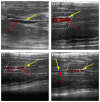Normal Blood Flow in Rat Abdominal Aorta: An Ultrasound Study
- PMID: 40564103
- PMCID: PMC12189930
- DOI: 10.3390/biomedicines13061385
Normal Blood Flow in Rat Abdominal Aorta: An Ultrasound Study
Abstract
Background/Objectives: Ultrasound Doppler diagnostics is a modern diagnostic method, routinely used to determine the blood flow velocity in vessels in clinical practice and scientific experiments. The aim of this study was to investigate hemodynamics and identify blood flow velocity norms for various age groups of animals in the range of two to six months. Methods: This study presents the blood flow velocity characteristics in different areas of the abdominal aorta of 30 growing Wistar rats two to six months old. The data from senile rats aged 24 months were used as a reference, since these animals should not show any changes in hemodynamics associated with the active growth of the organism. Ultrasound screening in the group of growing rats was performed monthly, and blood flow velocity was measured at three points: proximal to the renal arteries, distal to the renal arteries, and before the bifurcation zone of the abdominal aorta. Conclusions: The obtained data can be used as normative values in in vivo small-diameter tissue-engineered vascular graft (TEVG) studies to assess changes in hemodynamics.
Keywords: Wistar rats; abdominal aorta; blood flow velocity; hemodynamics; ultrasound examination.
Conflict of interest statement
The authors declare no conflicts of interest.
Figures


Similar articles
-
Duplex ultrasound for diagnosing symptomatic carotid stenosis in the extracranial segments.Cochrane Database Syst Rev. 2022 Jul 11;7(7):CD013172. doi: 10.1002/14651858.CD013172.pub2. Cochrane Database Syst Rev. 2022. PMID: 35815652 Free PMC article.
-
Epidural therapy for the treatment of severe pre-eclampsia in non labouring women.Cochrane Database Syst Rev. 2017 Nov 28;11(11):CD009540. doi: 10.1002/14651858.CD009540.pub2. Cochrane Database Syst Rev. 2017. PMID: 29181841 Free PMC article.
-
Efficacy of nicergoline in dementia and other age associated forms of cognitive impairment.Cochrane Database Syst Rev. 2001;2001(4):CD003159. doi: 10.1002/14651858.CD003159. Cochrane Database Syst Rev. 2001. PMID: 11687175 Free PMC article.
-
Comparison of cellulose, modified cellulose and synthetic membranes in the haemodialysis of patients with end-stage renal disease.Cochrane Database Syst Rev. 2001;(3):CD003234. doi: 10.1002/14651858.CD003234. Cochrane Database Syst Rev. 2001. Update in: Cochrane Database Syst Rev. 2005 Jul 20;(3):CD003234. doi: 10.1002/14651858.CD003234.pub2. PMID: 11687058 Updated.
-
Inhaled mannitol for cystic fibrosis.Cochrane Database Syst Rev. 2018 Feb 9;2(2):CD008649. doi: 10.1002/14651858.CD008649.pub3. Cochrane Database Syst Rev. 2018. Update in: Cochrane Database Syst Rev. 2020 May 1;5:CD008649. doi: 10.1002/14651858.CD008649.pub4. PMID: 29424930 Free PMC article. Updated.
References
-
- Cuenca J.P., Kang H.J., Fahad M.A.A., Park M., Choi M., Lee H.Y., Lee B.T. Physico-mechanical and biological evaluation of heparin/VEGF-loaded electrospun polycaprolactone/decellularized rat aorta extracellular matrix for small-diameter vascular grafts. J. Biomater. Sci. Polym. Ed. 2022;33:1664–1684. doi: 10.1080/09205063.2022.2069398. - DOI - PubMed
Grants and funding
LinkOut - more resources
Full Text Sources

